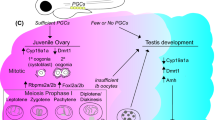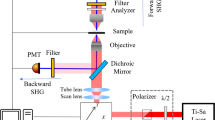Abstract
A fast and simplified two-color in situ hybridization procedure for the simultaneous detection of two different mRNAs in whole-mounted zebrafish and Drosophila embryos is presented. Transcript distributions are detected in a single incubation step using a mixture of alkaline phosphatase and β-galactosidase coupled antibodies. The different transcripts are visualized in contrasting colors by the use of β-galactosidase substrates that develop color precipitates (magenta, blue) easily distinguishable from those of the standard alkaline phosphatase substrates. This protocol can be followed by standard immunohistochemistry to detect the expression of a third gene (at the protein level) in a third color.
Similar content being viewed by others
Author information
Authors and Affiliations
Additional information
Received: 1 December 1998 / Accepted: 19 January 1999
Rights and permissions
About this article
Cite this article
Hauptmann, G. Two-color detection of mRNA transcript localizations in fish and fly embryos using alkaline phosphatase and β-galactosidase conjugated antibodies. Dev Gene Evol 209, 317–321 (1999). https://doi.org/10.1007/s004270050258
Issue Date:
DOI: https://doi.org/10.1007/s004270050258




